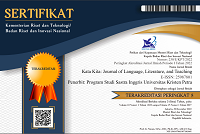Written Corrective Feedback and Its Effects on English Department Students’ Writing Drafts
DOI:
https://doi.org/10.9744/katakita.2.2.33-40Keywords:
Museum Angkut, Visual Perception, Theme, Thematic, ZoneAbstract
This thesis investigates the teacher’s Written Corrective Feedback (WCF) strategies used in the students’ writing drafts and the effects analyzed from the comparison between the first and final drafts. It consists of fifty eight students’ writing drafts as the source of data limited to language use (LU) and vocabulary. The theories applied were the WCF strategies by Ellis (2009a); the effects of written feedback to students by Hyland (2003), and supported by Ferris (2006). The qualitative approach was used in this study. The finding revealed that the strategies used in the class were Direct CF (430 times), and Indirect CF (329 times). The effects were Error corrected, Incorrect change, No change, and Deleted text. Moreover, it was revealed that LU problem was more noticed by the students to be corrected. In conclusion, WCF can guide the students to be more aware of their mistakes and to improve their writing.References
Ellis, R. (2009a). A typology of written corrective feedback types. ELT Journal, 63(2), 97-107.
Ferris, D. (2006). ‘Does error feedback help student writers? New evidence on short- and long-term effects of written error correction’ in K. Hyland and F. Hyland (eds.). Feedback in Second Language Writing: Contexts and Issues. Cambridge: Cambridge University Press.
Gabrielatos, C. (2002). EFL writing: product and process. Retrieved September 29, 2013 from http://www.gabrielatos.com/Writing.pdf
Hyland, F. (1998). The impact of teacher-written feedback on individual writers. Journal of Second Language Writing, 7(3), 86-25.
Hyland, K. (2003). Second language writing. Cambridge: Cambridge University Press.
Hyland, K & Hyland, F. (2006). Feedback on second language students’ writing. Language teaching, 39(2), 83-101. Cambridge: Cambridge University Press.
Lounis, M. (2009). Students’ response to teachers’ feedback on writing: the case of third-year l.m.d students of English. Retrieved 20 May, 2013 from http://bu.umc.edu.dz/theses/anglais/MAH1104.pdf
Sheen, Y. & Ellis, R. (2011). Corrective feedback in language teaching. In E. Hinkel (Ed.), Handbook of research in second language teaching and learning. New York: Routledge.
Tangpermpoon, T. (2008). Integrated approaches to improve students writing skills for English major students. ABAC Journal, 28(2), 1-9
Downloads
Issue
Section
License
Authors who publish with this journal agree to the following terms:- Authors retain copyright and grant the journal right of first publication with the work simultaneously licensed under a Creative Commons Attribution License that allows others to share the work with an acknowledgement of the work's authorship and initial publication in this journal.
- Authors are able to enter into separate, additional contractual arrangements for the non-exclusive distribution of the journal's published version of the work (e.g., post it to an institutional repository or publish it in a book), with an acknowledgement of its initial publication in this journal.
- Authors are permitted and encouraged to post their work online (e.g., in institutional repositories or on their website) prior to and during the submission process, as it can lead to productive exchanges, as well as earlier and greater citation of published work (See The Effect of Open Access).














